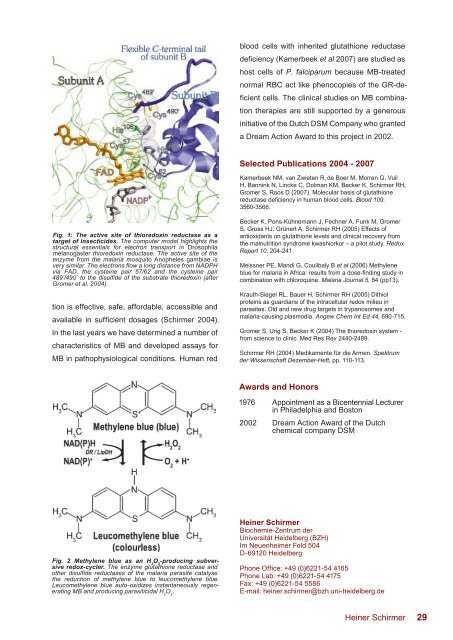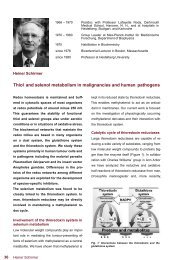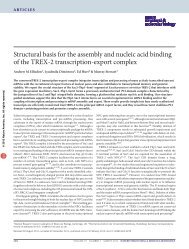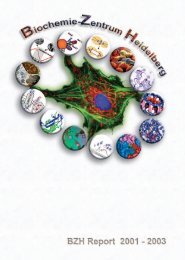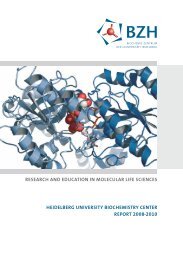Biochemie-Zentrum der Universität Heidelberg (BZH)
Biochemie-Zentrum der Universität Heidelberg (BZH)
Biochemie-Zentrum der Universität Heidelberg (BZH)
Create successful ePaper yourself
Turn your PDF publications into a flip-book with our unique Google optimized e-Paper software.
Fig. 1: The active site of thioredoxin reductase as a<br />
target of insecticides. The computer model highlights the<br />
structural essentials for electron transport in Drosophila<br />
melanogaster thioredoxin reductase. The active site of the<br />
enzyme from the malaria mosquito Anopheles gambiae is<br />
very similar. The electrons flow a long distance from NADPH<br />
via FAD, the cysteine pair 57/62 and the cysteine pair<br />
489’/490’ to the disulfide of the substrate thioredoxin (after<br />
Gromer et al. 2004).<br />
tion is effective, safe, affordable, accessible and<br />
available in sufficient dosages (Schirmer 2004).<br />
In the last years we have determined a number of<br />
characteristics of MB and developed assays for<br />
MB in pathophysiological conditions. Human red<br />
Fig. 2 Methylene blue as an H 2 O 2 -producing subversive<br />
redox-cycler. The enzyme glutathione reductase and<br />
other disulfide reductases of the malaria parasite catalyse<br />
the reduction of methylene blue to leucomethylene blue.<br />
Leucomethylene blue auto-oxidizes instantaneously regenerating<br />
MB and producing parasiticidal H 2 O 2 .<br />
blood cells with inherited glutathione reductase<br />
deficiency (Kamerbeek et al 2007) are studied as<br />
host cells of P. falciparum because MB-treated<br />
normal RBC act like phenocopies of the GR-de-<br />
ficient cells. The clinical studies on MB combina-<br />
tion therapies are still supported by a generous<br />
initiative of the Dutch DSM Company who granted<br />
a Dream Action Award to this project in 2002.<br />
Selected Publications 2004 - 2007<br />
Kamerbeek NM, van Zwieten R, de Boer M, Morren G, Vuil<br />
H, Bannink N, Lincke C, Dolman KM, Becker K, Schirmer RH,<br />
Gromer S, Roos D (2007). Molecular basis of glutathione<br />
reductase deficiency in human blood cells. Blood 109,<br />
3560-3566.<br />
Becker K, Pons-Kühnemann J, Fechner A, Funk M, Gromer<br />
S, Gross HJ, Grünert A, Schirmer RH (2005) Effects of<br />
antioxidants on glutathione levels and clinical recovery from<br />
the malnutrition syndrome kwashiorkor – a pilot study. Redox<br />
Report 10, 204-241.<br />
Meissner PE, Mandi G, Coulibaly B et al (2006) Methylene<br />
blue for malaria in Africa: results from a dose-finding study in<br />
combination with chloroquine. Malaria Journal 5, 84 (pp13).<br />
Krauth-Siegel RL, Bauer H, Schirmer RH (2005) Dithiol<br />
proteins as guardians of the intracellular redox milieu in<br />
parasites: Old and new drug targets in trypanosomes and<br />
malaria-causing plasmodia. Angew Chem Int Ed 44, 690-715.<br />
Gromer S, Urig S, Becker K (2004) The thioredoxin system -<br />
from science to clinic. Med Res Rev 2440-2489.<br />
Schirmer RH (2004) Medikamente für die Armen. Spektrum<br />
<strong>der</strong> Wissenschaft Dezember-Heft, pp. 110-113.<br />
Awards and Honors<br />
1976 Appointment as a Bicentennial Lecturer<br />
in Philadelphia and Boston<br />
2002 Dream Action Award of the Dutch<br />
chemical company DSM<br />
Heiner Schirmer<br />
<strong>Biochemie</strong>-<strong>Zentrum</strong> <strong>der</strong><br />
<strong>Universität</strong> <strong>Heidelberg</strong> (<strong>BZH</strong>)<br />
Im Neuenheimer Feld 504<br />
D-69120 <strong>Heidelberg</strong><br />
Phone Office: +49 (0)6221-54 4165<br />
Phone Lab: +49 (0)6221-54 4175<br />
Fax: +49 (0)6221-54 5586<br />
E-mail: heiner.schirmer@bzh.uni-heidelberg.de<br />
Heiner Schirmer<br />
29


